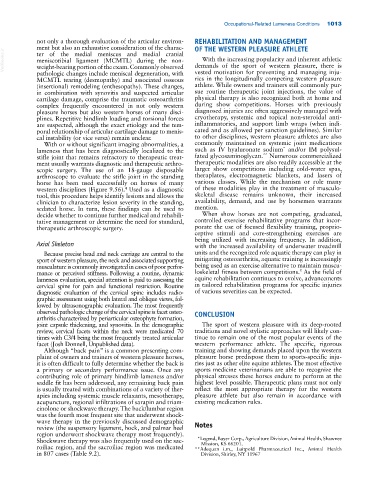Page 1047 - Adams and Stashak's Lameness in Horses, 7th Edition
P. 1047
Occupational‐Related Lameness Conditions 1013
not only a thorough evaluation of the articular environ REHABILITATION AND MANAGEMENT
ment but also an exhaustive consideration of the charac OF THE WESTERN PLEASURE ATHLETE
VetBooks.ir meniscotibial ligament (MCMTL) during the non‐ demands of the sport of western pleasure, there is
ter of the medial meniscus and medial cranial
With the increasing popularity and inherent athletic
weight‐bearing portion of the exam. Commonly observed
pathologic changes include meniscal degeneration, with vested motivation for preventing and managing inju
MCMTL tearing (desmopathy) and associated osseous ries in the longitudinally competing western pleasure
(insertional) remodeling (enthesopathy). These changes, athlete. While owners and trainers still commonly pur
in combination with synovitis and suspected articular sue routine therapeutic joint injections, the value of
cartilage damage, comprise the traumatic osteoarthritis physical therapy is also recognized both at home and
complex frequently encountered in not only western during show competitions. Horses with previously
pleasure horses but also western horses of many disci diagnosed injuries are often aggressively managed with
plines. Repetitive hindlimb loading and torsional forces cryotherapy, systemic and topical non‐steroidal anti‐
are suspected, although the exact etiology and the tem inflammatories, and support limb wraps (when indi
poral relationship of articular cartilage damage to menis cated and as allowed per sanction guidelines). Similar
cal instability (or vice versa) remain unclear. to other disciplines, western pleasure athletes are also
With or without significant imaging abnormalities, a commonly maintained on systemic joint medications
*
lameness that has been diagnostically localized to the such as IV hyaluronate sodium and/or IM polysul
**
stifle joint that remains refractory to therapeutic treat fated glycosaminoglycan. Numerous commercialized
ment usually warrants diagnostic and therapeutic arthro therapeutic modalities are also readily accessible at the
scopic surgery. The use of an 18‐gauge disposable larger show competitions including cold‐water spas,
arthroscope to evaluate the stifle joint in the standing theraplates, electromagnetic blankets, and lasers of
horse has been used successfully on horses of many various classes. While the mechanism or role many
4
western disciplines (Figure 9.56). Used as a diagnostic of these modalities play in the treatment of musculo
tool, this procedure helps identify lesions and allows the skeletal disease remains unknown, their increased
clinician to characterize lesion severity in the standing, availability, demand, and use by horsemen warrants
sedated horse. In turn, these findings can be used to mention.
decide whether to continue further medical and rehabili When show horses are not competing, graduated,
tative management or determine the need for standard, controlled exercise rehabilitative programs that incor
therapeutic arthroscopic surgery. porate the use of focused flexibility training, proprio
ceptive stimuli and core‐strengthening exercises are
being utilized with increasing frequency. In addition,
Axial Skeleton with the increased availability of underwater treadmill
Because precise head and neck carriage are central to the units and the recognized role aquatic therapy can play in
sport of western pleasure, the neck and associated supporting mitigating osteoarthritis, aquatic training is increasingly
musculature is commonly investigated in cases of poor perfor being used as an exercise alternative to maintain muscu
5
mance or perceived stiffness. Following a routine, dynamic loskeletal fitness between competitions. As the field of
lameness evaluation, special attention is paid to assessing the equine rehabilitation continues to evolve, advancements
cervical spine for pain and functional restriction. Routine in tailored rehabilitation programs for specific injuries
diagnostic evaluation of the cervical spine includes radio of various severities can be expected.
graphic assessment using both lateral and oblique views, fol
lowed by ultrasonographic evaluation. The most frequently
observed pathologic change of the cervical spine is facet osteo CONCLUSION
arthritis characterized by periarticular osteophyte formation,
joint capsule thickening, and synovitis. In the demographic The sport of western pleasure with its deep‐rooted
review, cervical facets within the neck were medicated 70 traditions and novel stylistic approaches will likely con
times with C3/4 being the most frequently treated articular tinue to remain one of the most popular events of the
facet (Josh Donnell, Unpublished data). western performance athlete. The specific, rigorous
Although “back pain” is a common presenting com training and showing demands placed upon the western
plaint of owners and trainers of western pleasure horses, pleasure horse predispose them to sports‐specific inju
it is often difficult to fully determine whether the back is ries just as other elite equine athletes. The most effective
a primary or secondary performance issue. Once any sports medicine veterinarians are able to recognize the
contributing role of primary hindlimb lameness and/or physical stresses these horses endure to perform at the
saddle fit has been addressed, any remaining back pain highest level possible. Therapeutic plans must not only
is usually treated with combinations of a variety of ther reflect the most appropriate therapy for the western
apies including systemic muscle relaxants, mesotherapy, pleasure athlete but also remain in accordance with
acupuncture, regional infiltrations of sarapin and triam existing medication rules.
cinolone or shockwave therapy. The back/lumbar region
was the fourth most frequent site that underwent shock
wave therapy in the previously discussed demographic
review (the suspensory ligament, hock, and palmar heel Notes
region underwent shockwave therapy most frequently).
Shockwave therapy was also frequently used on the sac *Legend, Bayer Corp., Agriculture Division, Animal Health, Shawnee
Mission, KS 66201.
roiliac region, and the sacroiliac region was medicated **Adequan i.m., Luitpold Pharmaceutical Inc., Animal Health
in 807 cases (Table 9.2). Division, Shirley, NY 11967

